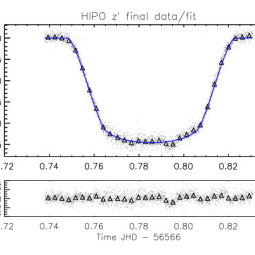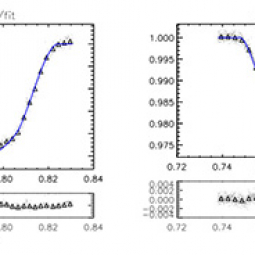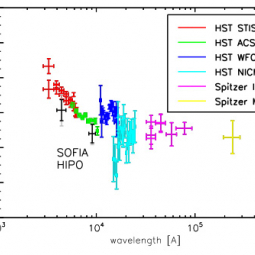The first observations of an extrasolar planet by NASA’s SOFIA (Stratospheric Observatory for Infrared Astronomy) are reported in a paper published online on July 8 in the Journal of Astronomical Telescopes, Instruments, and Systems (JATIS) by Daniel Angerhausen (NASA Goddard Space Flight Center and Rensselaer Polytechnic Institute) and collaborators. Members of Angerhausen’s team include principal investigator Avi Mandell of NASA Goddard, other astronomers at NASA Goddard, Lowell Observatory in Flagstaff, Arizona, and UCLA, plus SOFIA science staff members from the Universities Space Research Association (USRA) at NASA Ames and the German SOFIA Institute at the University of Stuttgart.
The star HD 189733, located 63 light years away in the direction of the constellation Vulpecula (the Fox), has spectral type K1.5, meaning it is somewhat smaller and cooler than our Sun. The planet, designated HD 189733b, is a “hot Jupiter,” a large, probably gas-dominated planet that orbits its parent star 30 times closer than Earth is to the Sun.
The orbit of the planet is fortuitously oriented so that we on Earth see the planet silhouetted against the star as it moves along on that portion of its orbit, blocking approximately 2.5% of the star’s light for about 2 hours during each 2.2-day orbit. Such mini-eclipse events are called ‘transits.’ HD 189733b is the nearest known transiting “hot Jupiter” to Earth, and therefore has been the subject of many investigations since its discovery in 2005.
Observations of one HD 189733b transit event in October 2013 were made using SOFIA’s HIPO (High Speed Imaging Photometer for Occultations) instrument. The upper pair of plots below, corresponding to the top panels in Figures 5 and 6 from the Angerhausen et al. paper, show “light curve” records of the transit at two wavelengths designated B (445 nm; left) and z’ (905 nm; right). The horizontal axes of the plots give time in units of fractions of a day (0.01 days equals 14.4 minutes). The vertical axes show the observed brightness of the star during the transit, with 1.000 representing its full brightness when the planet is in the portions of its orbit where it does not block the star’s light from Earth’s perspective.
The lower pair of plots show departures from fits to the overall shapes of the light curves. These data allow Angerhausen et al. to confirm previously reported results regarding the light-scattering properties of the planet HD 189773b’s atmosphere, indicating the possible presence of a haze of dust grains.
Angerhausen et al. also used their data to conduct a “pilot” study of SOFIA’s general capabilities regarding such especially difficult extrasolar transit observations. Their conclusion is that SOFIA is a good platform for photometric observations of this kind. The uncertainty in SOFIA’s determination of the planet’s size is 5-10 times better than what has been obtained from the ground, with quality closer to that of data from space-borne telescopes such as HST and Spitzer (Angerhausen et al. Figure 7).
J. Astron. Telesc. Instrum. Syst. 1(3), 034002 (Jul 07, 2015). doi:10.1117


